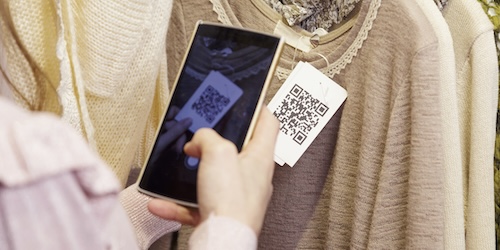
Listen to this blog
How GS1 Digital Links Help Apparel Brands Build Loyalty
The apparel industry, much like all consumer goods, is on the cusp of a significant transformation. As the global shift from traditional UPC barcodes to 2D barcodes/QR codes accelerates with the fast-approaching GS1 Digital Link requirement, apparel companies have an unprecedented opportunity to more deeply engage with and inform consumers.
What are GS1 Digital Links?
The GS1 Digital Link creates a QR code (2D barcode) that represents a product, enabling seamless data transfer between consumers, brands, and various parties in the supply chain. Unlike standard UPC barcodes, which don't support this level of data connectivity, GS1 Digital Link enhances transparency, provides real-time product information, and strengthens consumer engagement. In practical terms, the “unintelligent” UPC barcode will be replaced by a QR code, readable in checkout and with smartphones.
GS1 Digital Link marks the first time in 50 years that unique product identifiers have evolved; the UPC barcode was introduced in the United States in 1974. It replaced manual product pricing labels and manual cash register inputs at checkout.
The new protocol not only gives apparel (plus furniture, textiles, and home goods) brands the opportunity to share product information with consumers. It also supports product authenticity, sustainability and recycling, and helps products meet regulatory compliance. Here are just some of the ways GS1 Digital Links and digital product pages are revolutionizing the industry and preparing brands for the future.
GS1 Digital Links for Apparel & Textiles
GS1 Digital Links offer a robust solution for the apparel and textiles sector, bringing clothing items online in a seamless manner. By incorporating digital links, brands can validate the authenticity of their products efficiently, connect directly with shoppers, and prepare for compliance with GS1 Digital Links and the EU Digital Product Passport.
One of the primary benefits of GS1 Digital Links is the ability to verify authenticity with a single QR code. This capability significantly reduces counterfeits and reassures both consumers and retailers about the genuineness of the products they purchase and sell. In an industry where fake clothing products account for 30% of the global counterfeit market, this feature is invaluable.
QR codes can validate authenticity not only at the point of purchase, but at resale as well. Let’s say you’re a high-end brand, and your customer wanted to offload your product. They could sell it on eBay or Facebook Marketplace… Or they could scan the QR code and learn that you would buy back the item, or they could trade it in for credit towards the latest season’s offering. You would build brand loyalty and have the opportunity to acquire the item, re-authenticate the item and sell it yourself.
Digital links also help apparel brands anticipate compliance challenges, such as getting ready for the Digital Product Passport for textiles and preventing losses. By embracing GS1 Digital Links, companies can unlock next-level supply chain management. This standardized system tracks products throughout their journey, ensuring accurate monitoring from production to retail. This aids in timely inventory adjustments, minimizes waste, and promotes sustainable practices.
Digital Product Passport-ready
The introduction of the EU Digital Product Passport (DPP) mandates that all textile products in EU countries provide detailed manufacturing information via a QR code. GS1 Digital Links are the ideal solution to comply with these new regulations without cluttering labels and packaging. By adopting digital link QR codes now, apparel companies can set up sustainable procedures and tools, avoiding potential "product passport meltdowns."
Mandates aside, a DPP is a digital page that includes all types of detailed product information. This includes information you might already have on an ecommerce product page, but think beyond these details. You can share the entire supply chain journey of your product, from the fields of cotton to the hand-made buttons. Or share how your products support sustainability or recycling.
These QR codes are designed to create and maintain updated digital product pages, ensuring that all relevant details and links required by law are easily accessible. This not only helps in regulatory compliance but also strengthens authenticity and trust. Illicit competition from counterfeiting and gray market diversion costs fashion brands around $60 billion annually, undermining brand integrity and eroding consumer trust.
Embracing Next-Level Marketing
You may be starting to get the picture that QR codes plus DDPs create a huge opportunity to better communicate with consumers. Here are a few highlights of this capability.
Building One-to-One Relationships
GS1 Digital Links enable apparel companies to build deeper connections with their customers. Think about it: a QR code creates an always-on channel that’s attached to your product. It’s not a hang tag that’s only useful at point-of-sale, or an indiscernible care tag. This one code can deliver unlimited information to your consumers all along their customer lifecycle.
By turning products into always-on channels with brand fans, companies can engage brand lovers anytime, anywhere. Imagine tailoring content based on interactions—whether someone scanned a digital link QR code before or after a purchase, from a specific country, or even at a certain time of day. This level of personalization enhances brand loyalty and creates unique shopping experiences.
Collecting Firsthand Insights from Shoppers
Digital link QR codes transform how apparel companies understand their products' post-purchase journey. Every scan is meticulously logged, offering geolocated information spanning an item's extended lifecycle. This data is a treasure trove for driving design and marketing innovations. Fashion brands can now tap into the narrative of how clothing and accessories are used and cherished once they find a place in someone's wardrobe.
Key Use Cases for Digital Links in Apparel
Apparel Inventory Management using GS1 Digital Links
- Capturing Serialized Sales Data: GS1 Digital Links enable the capture of detailed sales data at the point of sale, unlocking robust sales insights.
- Merchandising: Store associates can use 2D barcodes for retail applications, such as displaying seasonal planograms and marking down merchandise.
- Returns Management: Serialization simplifies returns by identifying each specific product sold, reducing the need for additional barcode stickers.
- Mis-Mates: 2D barcodes can identify when paired products are not returned as a set, reducing inventory loss.
- Reverse Logistics: Scanning 2D barcodes helps store associates manage the disposition of returned merchandise efficiently.
- Loss Prevention: The combination of RFID and 2D barcodes helps detect merchandise that has left the store without being sold.
Apparel Traceability using GS1 Digital Links
- Supply Chain Visibility: 2D barcodes can include country-of-origin information, enhancing supply chain transparency.
- Sustainability Data: Adding batch/lot information or SGTINs to 2D barcodes can track sustainability attributes like raw materials and certifications.
- Legislation: GS1 Digital Links support compliance with upcoming legislation, such as the European Digital Product Passport.
- Product Contents: 2D barcodes can convey necessary product attributes for customs, such as HTS codes and hazardous materials information.
Consumer Engagement
- Care Information: Direct consumers to care instructions or content pages for more product details.
- Expiration: Help consumers dispose of expired products like cosmetics and candy.
- Promotions: GS1 Digital Links allow for dynamic messaging and special promotions via 2D barcodes.
- Sustainability Information: Share ecolabel information with consumers about specific products.
- Product Authenticity: Guide consumers to a product authentication page, confirming the purchase of authentic merchandise.
- Circularity: Provide consumers with instructions for sustainable product disposal.
The future of fashion is digital
The transition from UPC barcodes to QR codes, powered by GS1 Digital Links and digital product pages, is revolutionizing the apparel industry. By adopting these technologies, apparel companies can enhance product authenticity, engage consumers more effectively, comply with regulatory requirements, and optimize supply chain management. The future of fashion lies in digital innovation, and embracing GS1 Digital Links is a critical step in staying ahead of the curve.
As a vanguard in the branded link and QR code space, BL.INK, a GS1 US Solution Partner, currently works with global brands to align with GS1 Digital Link standards. But we’re doing much, much more. Our technology’s ability to integrate with any internal or external brand data makes us a seamless partner in streamlining the GS1 Digital Link process for brands in the apparel or textiles industries. Read more about what we’re doing on our GS1 Digital Link page.



